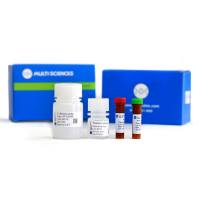品牌商
杭州联科生物技术股份有限公司
入驻年限:13 年
- 联系人:
李先生
- 所在地区:
浙江 杭州市 萧山区
- 业务范围:
抗体、细胞库 / 细胞培养、实验室仪器 / 设备、医疗器械、体外诊断
- 经营模式:
代理商 生产厂商 科研机构 医院药店
推荐产品

小鼠白介素1βELISA酶联免疫试剂盒Mouse IL-1β ELISA Kit 小鼠 白介素1beta 联科生物 MultiSciences
品牌:MultiSciences
¥1600 - 2650
咨询公司新闻/正文
「中国神经科学学会第十二届全国学术会议」天津聚会
人阅读 发布时间:2017-09-28 11:41

「中国神经科学学会第十二届全国学术会议」将于2017年10月12日-15日在天津盛大举行。本次大会将对近年来我国乃至世界神经科学的最新发展及其科研成果进行研讨交流。会议邀请国内外著名专家做大会报告,全国各大医院神经科学专家以及相关科室负责人,全国大专院校、科研院所等单位的神经科学专家学者将会参加本次大会,开展学术上的自由讨论,促进我国神经科学事业的繁荣发展。
联科生物(06号展位)作为特约赞助商参加此次会议,
展台不仅备有精装产品资料及小礼品,更有幸运抽奖活动等您来,奖品丰厚,不容错过!

会议时间:2017年10月12日-15日
会议地点:天津.社会山会议中心(天津市西青区南站知景道198号)
会议官网:中国神经科学学会第十二届全国学术会议
> 大会报告人
| 徕卡讲座 | |
| Speaker: | John Rubenstein美国加州大学旧金山分校 ,美国医学科学院院士,美国人文与科学院士 |
| Time: | Oct.13, 08:30-09:15 |
| Title: | Transcriptional Regulation of TelencephalonDevelopment |
 |
John Rubenstein, MD, Phd is a Professor in the Department of Psychiatry at the University of California San Francisco. His research focuses on the regulatory genes that orchestrate development of the forebrain.In the mammalian embryo, the forebrain is the portion of the neural tube where primitive cells are organized to form the cerebral cortex, the basal ganglia and other components of the adult brain -- the structures of the human brain most involved in key functions such as speech, language, cognition and fine motor skills. |
| 张香桐纪念讲座 | |
| Speaker: | Chris I. de Zeeuw,荷兰鹿特丹伊拉斯谟大学医学中心神经科学系主任 ,荷兰皇家艺术和科学院院士 |
| Time: | Oct.13, 15:15-16:00 |
| Title: | Why Does Our Cerebellum Create Better Movements Than Robots? |
 |
Prof. Dr. C.I. (Chris) De Zeeuw is chair at the Dept. of Neuroscience of Erasmus MC in Rotterdam, and vice-director of the Netherlands Institute for Neuroscience of the Royal Dutch Academy of Arts & Sciences (KNAW) in Amsterdam.The group of De Zeeuw aims to tackle this central theme by investigating plasticity and dynamics of sensorimotor systems that control readily tractable motor behaviours. Three lines of objectives and research can be distinguished: to elucidate the role of thevestibulocerebellum in the performance and adaptation of compensatory eye movements; to elucidate the role of the olivocerebellar system in eyelid conditioning; and to elucidate the functional interactions between the cerebellum and cerebral cortex during adaptation to perturbations in locomotion. |
| 吴建屏纪念讲座 | |
| Speaker: | Klaus-Armin Nave,Max Planck实验医学研究所神经遗传学部, 德国科学院院士 |
| Time: | Oct.14, 08:30-09:15 |
| Title: | Powering axons: novel functions of oligodendrocytes in energy metabolism |
 |
We are interested in the mechanisms of neuron-glia interactions in the higher nervous system, and in the genes that are required for normal glial cell function. Here, transgenic and mutant mice have become important to study developmental processes as well as genetic diseases. For example, oligodendrocytes are glial cells highly specialized for enwrapping CNS axons with multiple layers of membranes, known to provide electrical insulation for rapid impulse propagation. We found that oligodendrocytes are also essential for maintaining the long-term integrity of myelinated axons, independent of the myelin function itself. The mechanisms by which oligodendrocytes support long-term axonal survival are still under investigation. The importance of glial cells as the "first line of neuroprotection", however, is illustrated by several myelin-associated diseases in which axonal neurodegeneration contribute to progressive disability. These range in humans from peripheral neuropathies (CMT1) to spastic paraplegia (SPG2), and presumably multiple sclerosis (MS) and certain forms of psychiatric disorders. We are developing transgenic animal models for some of these diseases, in order to dissect the underlying disease mechanisms and, in the case of CMT1A, have used these models to design novel therapeutic strategies. |
| 大会报告 | |
| Speaker: | Yimin Zou 美国加州大学圣地亚哥分校 |
| Time: | Oct.13, 14:30-15:15 |
| Title: | Axon guidance cues in development and repair of neural circuits |
 |
Prof. Zou is interested in the wiring, function and disorders of neural circuits. His lab studies molecular and cellular mechanisms of axon guidance, synapse formation and regeneration in the central nervous system. His lab pioneered the finding that the Wnt family morphogens are axon guidance molecules, directing the pathfinding and topographic projection of axons along the major axes of the central nervous system. We were also the first to show that planar cell polarity and apical-basal polarity signaling pathways steer growth cones. In addition, his work established that axon guidance molecules and their signaling pathways are reactivated in adult central nervous after traumatic injury and play important roles in functional recovery. More recently, he found that planar cell polarity signaling components play critical roles in glutamatergic synapse formation (in press). |
| Speaker: | Sheena A. Josselyn 加拿大多伦多大学生理系及附属病童医院 |
| Time: | Oct.14, 14:00-14:45 |
| Title: | Making, Breaking and Linking Memories |
 |
The research in my laboratory is dedicated to understanding the neural basis of cognitive function and dysfunction. To unravel the molecular, cellular and circuit processes that underlie learning and memory we employ a multidisciplinary approach including the use of transgenic mice, gene deletion 'knockout' mutants, and 'knock in' mutants which carry a specific point mutation, biochemistry, pharmacology, neuroanatomical lesions and detailed behavioral analysis. The guiding rationale behind this work is the finding that long-term memory (LTM) involves structural re-modeling of synaptic connections and consequently, requires gene expression and de novo protein synthesis.Our lab focuses on the transcription factors that regulate the protein synthesis necessary for LTM formation. The second broad theme of our research examines the pathogenesis of human cognitive disorders. By building on the findings from our basic research theme to the study of cognitive dysfunction in humans, we hope to develop new therapeutic targets and treatment strategies. |
| Speaker: | Carsten K.W. De Dreu 荷兰莱顿大学心理学研究所 荷兰皇家学会院士 |
| Time: | Oct.15, 08:30-09:15 |
| Title: | The Neuroscience of Care and Conflict within and between Human Groups |
 |
Prof. Carsten K.W. De Dreu is full professor at Leiden University (Social and Organizational Psychology), at the Center for Experimental Economics and Political Decision Making (CREED) at the University of Amsterdam, and Distinguished Research Fellow at the University of Oxford. He is an elected fellow of several learned societies, including the Society for Personality and Social Psychology, Association for Psychological Science, and the Royal Netherlands Academy of Sciences. He is a former president of the International Association for Conflict Management (2001), and the European Association for Social Psychology (2008-2011). His scientific research and teaching focuses on the neurobiological and psychological underpinnings of cooperative decision making, conflict regulation, group decision making, and creativity. On these and related topics he published widely in scientific journals such as Science, Proceedings National Academy of Sciences, Psychological Bulletin, Journal of Applied Psychology, and Journal of Personality and Social Psychology. For his work he received several awards, including most influential article awards from the Academy of Management (2009, 2010), the William Owens Scholarly Achievement Award from the Society of Industrial and Organizational Psychology (2014), the 2014 Kurt Lewin Medal for mid-career achievements in social psychology from the European Association of Social Psychology, and the 2015 KNAW-Hendrik Muller Award for his contributions to the Social and Behavioral Sciences. De Dreu attracted over 5M€ in external research funding, and supervised 9 postdoctoral and 29 PhD students. |
| Speaker: | 马秋富 教授 美国哈佛大学医学院 |
| Time: | Oct.15, 14:00-14:45 |
| Title: | Take a step back: mapping spinal circuits and rethinking current pain research |
 |
Prof. Ma is interested in studying the neural circuits involved with the senses of pain, itch, touch, and temperatures. According to population coding hypothesis, each of these somatic sensory modalities is processed along a specific neural circuit or a labeled line, but the emergency of a specific sensation in response to a particular sensory stimulus is often involved with a cross talk among these labeled lines, due to polymodal nature of most sensory neurons. For example, both pain-related and itch-related sensory neurons respond to capsaicin, the pungent ingredient in "hot" chili peppers, but capsaicin injection in humans evokes only pain, due to a dominant suppression of itch by pain. Our research focuses on two related areas. One is to understand the genetic programs that control the assembly of specific sensory-labeled lines. The other is to characterize the neural circuits underlying cross interaction among distinct sensory-labeled lines by developing new genetic tools to mark and ablate specific neuronal populations in the dorsal spinal cord. |








